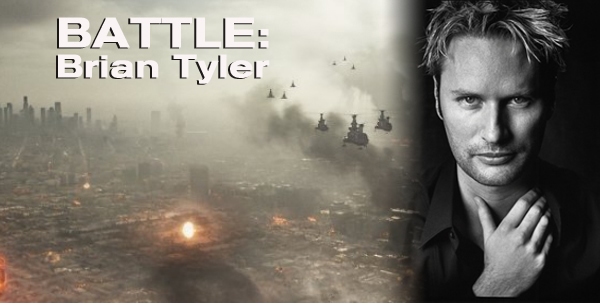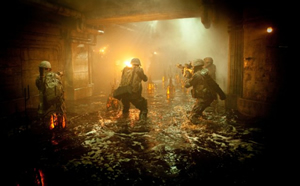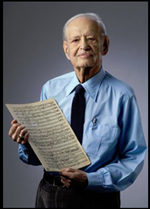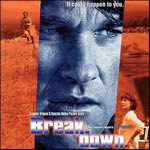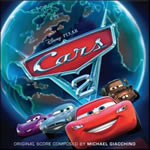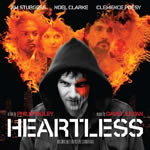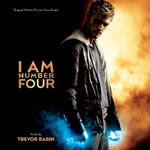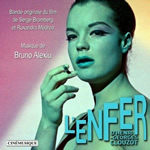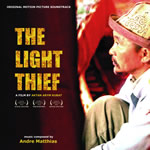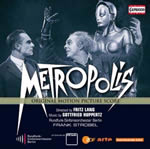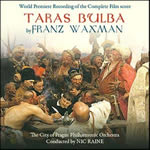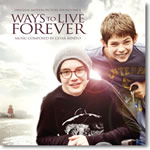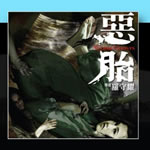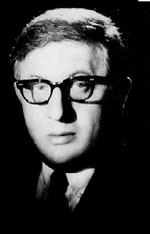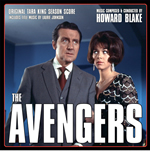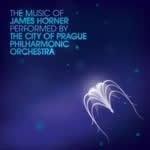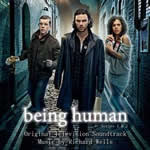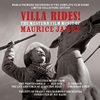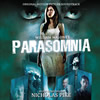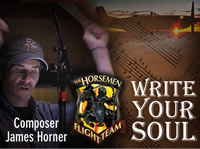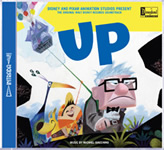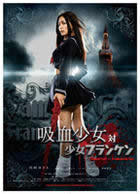
 |
Soundtrax: Episode 2011-7
July 3, 2011By Randall D. Larson
Scoring alien invasions, furious car chases, television, and a fifth destination.
In a little over thirteen years, composer Brian Tyler has emerged into the world of major Hollywood blockbusters, scoring huge science fiction and action pictures like BATTLE: LOS ANGELES, FAST FIVE, and FINAL DESTINATION 5, while also finding time to compose for interesting television series like TRANSFORMERS: PRIME and the new HAWAII FIVE-O. I discussed all of these projects with Brian who described in detail his intentions, challenges, and perspectives.
Q: What is the musical psychology of this kind of sci-fi action film?
Brian Tyler: I think science-fiction breaks down into different categories. This would fall into the camp that has a bit more realism to it, in terms of at least the tone of the situation. It’s very grave at times. And I think that lends itself to either going one of a couple ways. One would be to write very dark music, or else to take a serious tone that has a very gritty feel to it. There was an angle that we wanted to take on this film that was a little bit more soulful, because you’re with these marines and they’re these blue-collared guys that are fighting this spectacular battle, but you’re still kind of with them. Certain science-fiction movies would focus on the slickness of the hardware, battles in space, or things like that, and the music would have a kind of sheen to it that speaks to that ilk. As much as I love that kind of music, that’s something we couldn’t do.Q: This score seems to be more grounded in reality.
Brian Tyler: Yes. It comes close to being patriotic. It’s not meant to be an American tale, particularly, even though it takes place here. It has become an us-against-them story. I think you can do a film that can speak to a serious subject even though it’s completely fictional. In the 80s we had movies in which the bogeyman was the Russians. We had that so long during the Cold War. Now war movies seem to be divided between three categories: either you’re historical, you can do World War I, you can do the Nazis, and they’re always good bad guys, because everyone hates the Nazis. You can go throughout history, or you could be contemporary and go with terrorism, or you can go with the great new bogeyman, which is aliens. Because of post-9/11, the enemy has become a bit nebulous. It’s not a defined target like, the Russians or the Nazis, or whatever it might be. And since we kind of don’t almost know who we’re fighting, it seems to me that the idea of a serious film about an alien invasion has kind of finally come into its own and can be taken more seriously. It’s the closest literary or filmic cousin to what’s really going on. So was kind of the starting-off point for me – to not deviate too far from this kind of reality vibe and keeping it soulful. In a way probably the closest movie to BATTLE LA isn’t really another science-fiction movie, it’d probably be something like Black Hawk Down.Q: How does the score the handle character interaction after the attack versus the action music for the initial attack?
Brian Tyler: You have to tell the story from the beginning for each one of these characters. If you’re doing a film about a historical event, say World War I or II or something set in Vietnam, you have people from history and so there’s a knowledge of that character. An audience brings with them a background knowledge of the characters they’re about to watch. We don’t have that luxury – no one in this film exists. So you can’t focus on throwing yourself into a scene from Normandy right from the get-go. You have to really get into things very early on. There’s the preamble to the attack, which establishes some themes and whatnot, but the attack itself is just completely insane. And the music hopefully gives a bit of a face to the faceless enemy in that it is monolithic and cold and unforgiving and merciless; it has a completely different moral compass than we do. That’s why that music is so brutal. And then as you get into it, the music builds the character development by way of reaction to the surroundings. I could never really get ahead of the characters musically and neither could Jonathan [Liebesman], the director, because you just can’t in a movie like this. You have to be reactive to the situation.BATTLE: LA is really almost a first-person point-of-view movie. You pick your marine, and you’re one of them. You’re going through in real time almost the experience. There’s no kind of first person omniscient narrator in the story who knows all the geography of what’s going on in the battle – you’re just thrown into the middle of it and all of the sudden you’re behind enemy lines and you don’t even know who the enemy is. The majority of the movie focuses on the perspective of the humanity of it and it’s moment by moment survival. So the music had to go with that vibe as opposed to telling an overall story from some kind of omniscient perspective. I had to stay true to ‘don’t get ahead of what we see on screen.’
Q: How did the aliens’ texture and motif interact with that of the humans?
Brian Tyler: They had a very cold sound. I think there are conventions to film scoring that you need to follow and then there are conventions that you can break, but one of the conventions is that the bad guys shouldn’t have a lovely theme. It’s not really a melodic theme, actually, it’s more kind of motif. It’s primarily dissonant, without a set structure. There’s this off-kilter chord that I use over and over for them. It’s kind of a biomechanical vibe. For the alien music I often would record the orchestra and I’d run it through various guitar pedals so the brass sounded distorted and a little weird. They were old style pedals, from the 70s and things like that, so it gave us these weird almost electronic overtones. Then I’d mix that with the straight-ahead through-the-microphone recording. It had the effect of making the brass sound a little bit odd. I used very low instruments – cimbasso, bass trombone, and tuba, combined with contrabass. It didn’t feel like I could move into the world of the Imperial March vibe. The alien civilization was not organized in a fashion that we recognize or can relate to. The only thing that we relate to was that they had troops and they strategize. You can’t go too far into the melodic world for them; that’s really reserved for the humans of the film.Q: How did you use electronics as an element of the musical design of the score?
Brian Tyler: There were a few instruments that I used that were maybe a little odd to use in a score like this. There were so many elegies and battle hymns, which really are more 19th century-styled folk music, but they were enhanced by these varied ambient guitars played in a kind of fast tremolo strum style to make these long soaring notes in the background, more along the lines of a Sigur Ros, where it’s used as a texture as opposed to a rock guitar sound. The electric guitars made up most of the electronic component of the score. Sometimes there’d just be very feedback and you wouldn’t really be sure what that kind of instrument was in the background. Then I played things like electric viola, electric cello, that blended with the guitars to create an electronic landscape although it all came from an organic source.Q: Use of electric guitar as an orchestral instrument is being more accepted in scores nowadays. We’re hearing it more often as the lead instrument for the melodic motif in orchestral score.
Brian Tyler: Right. It definitely used to be rare. INCEPTION came out while I was composing BATTLE LA, and I was glad to see that Hans was using a guitar thing that moves also with the orchestral stuff, as opposed to kind of having the non-orchestral music be just keyboard, which to me isn’t as interesting.Q: How has music for action films evolved over the last ten years? What has prompted that change in approach?
Brian Tyler: That’s a good question. I think there’s probably more of like a twenty-year arc to it, where you see that it has become almost more melodically-based with classical orchestration and surroundings. We’re evolving from the completely straight-ahead, traditional action score – which I love and which got me into scoring in the first place – and it’s become something that has to be contained in a way that speaks also through the sound effects in a film. That’s a big challenge for composers now. You’re faced with Pro Tools and things where you can have a bazillion tracks of sound effects, and the music is still just one element of that. Because of that, the musical score had to find a way to be heard in a way. Melody had to be distinct in terms of longer lines. I’ve never really thought about that musical evolution but when I listen a score I can go, yeah, yeah, that’s probably from ‘83. You can certainly tell the difference between ‘90s, ‘70s, ‘60s. There are exceptions of course. The thriller genre is the one that’s changed the least since the ‘60s. You throw in a Bernard Herrmann score now and it sounds great, and the style of music in movies like HARRY POTTER and STAR WARS still works great. It’s more the wartime movies – if you looked at a war film from the ‘70s or the ‘80s it will probably have a lot more ornamentation in it, orchestrally, than now. There were less frills, there were faster melodies and more of a heroic outlook in the music. That has given way, especially in the last ten years, probably because of 9/11, to something with a little bit more of a bleak outlook tonally. You could actually look at something like INDEPENDENCE DAY, which is an invasion movie with a score that I really love, and there’s a lot more fanfare and a lot more victory in the sound. It has more of that kind of ‘we won’ type of vibe.Q: It’s a cheerleading score.
Brian Tyler: It’s very into the moment. I think scores now are geared towards trying to at least paint the illusion that you’re really there, and the music is of course doing a bit of a magic trick to do that. You end up having an experience that’s further removed from what it would really be if you were on the battlefield, and the score is there to kind of make up the difference for the fact that you’re sitting in a nice comfortable chair.
Q: What can you tell me about FAST FIVE?
Brian Tyler: That one was quite a challenge. There’s been an evolution since the first film, since there’s been more and more score for each film; it’s almost as if the cast has gotten older and the stories have warranted more and more score. The films become more and more, for lack of a better word, serious. I mean this one’s a lot of fun and there’s a lot of comedy in it, but they become more like a full-on action film with a storyline versus kind of the cinematic equivalent of going to a club. And now, five movies in, we’re so far removed from that vibe. Even though we still have the same characters, the whole thing is a completely different beast. So in that sense we needed to make the music more thematic. We’re scoring these things with unconventional instruments but in a sense it’s using more and more of the true classic scoring devices, like motifs and themes.Q: How has the environment (America, Tokyo, etc.) affected your approach to the score?
Brian Tyler: It does change it. There was a definite undercurrent on TOKYO DRIFT because it was Japan, and we had the taikos and such. These scores are always divided for me because I’m doing the orchestral music – what you would term as normal film score music – and I’m also taking on these pieces in the FAST AND FURIOUS movies that in the past would be needle-drop, DJ-style tracks. Things that groups like Prodigy or Chemical Brothers or Dust Brothers would have contributed in the early days of FAST AND FURIOUS, I’m now doing for these films because Justin [Lin, director] wants it to be tailored to the movie. I divide my time between the two. So the kind of hip-hop that I worked on in TOKYO DRIFT had a Japanese slant to it. I listened to a lot of that kind of music there, and they use beats differently, and it’s got a whole vibe. Then the next one, the previous movie, FAST AND FURIOUS, had its own thing because it’s set in Brazil; so I played the charango, and the percussion was very Brazilian. FAST FIVE is again in Rio. I bought all these instruments for the film over the summer while they were shooting and I had this whole carnival percussion set-up, which is still in my studio, by the way – I guess it’s just going to stay here! You also have kind of this heist vibe, which is a whole new thing to the series, which has its own cheeky retro sense to it, almost like an early 1960s vibe, in a South American Ipanema style, that runs through those tracks. And then by the end of the movie you’re back into the most insane action music because the last sequence is sixteen of seventeen straight minutes of incredible action, which is combined with the heist material and the Brazilian instruments.Q: It’s a more complicated score than you would expect.
Brian Tyler: I think this one will be the most underestimated of mine in terms of level of difficulty. I don’t know if I’ll ever encounter something this difficult because even writing things like PARTITION which was a historical epic with all this Indian music – I had to learn the sitar – and then it has orchestra; but that was nothing in terms of the difficulty compared to trying to balance all of these elements throughout FAST FIVE and make them work together in a single tapestry. The movie’s two hours and ten minutes long and you’re bobbing and weaving throughout – sometimes it’s comedy, sometimes it’s heist music, sometimes there’s very serious drama, and then you have these crazy action sequences – the level of difficulty of trying to make certain themes work and all these different tones was pretty high for me.
Q: How did you map out the score as you were writing it, keeping all the themes and elements straight?
Brian Tyler: Well, in BATTLE LA it was something that was a bit more natural, because right from the outset you know what you’re up against – you’ve got the aliens and you’ve got our guys and you want to feel for them. So for that I composed a battle hymn that was a retrospective, kind of early 19th-Century American. So for that one, keeping it straight was more of a matter of just making sure I hit the right tone per scene. FAST FIVE, for starters, has like eleven main characters, and they’re very distinct. You have Don Omar and Tego Calderon and they’ve got this whole Dominican vibe, and then there’s Sung Tang who’s Asian-American so you want to hit that vibe, and then you have Tyrese Gibson and Ludacris and they’ve got their whole urban vibe thing that they’re doing, so they’re all completely distinct. And you throw in three characters that are from the original film, Vin and Brian and Jordana, and a couple different bad guys with a triangulated battle going on between them all – and then you throw them all in Brazil! You map it out on a big dry-erase board, and you’d have colored arrows pointing at everything denoting the themes, and I did that for each of these films. On FAST AND FURIOUS, I’d have twenty different colors, arrows flying all over the place, and Post-Its. It’s very hard to keep track of, but hopefully it all worked in the end. I’m really happy with how it came out and I’m glad people are responding to the movie because in a sense Justin did really an amazing job with it. It’s been getting like 80 on Rotten Tomatoes from the critics – pleasing them is one thing, but pleasing the audience was the big thing for us. We made it for the fans, but it’s such a critical piñata – there’s a built-in critical bias against the film, first that it’s a FAST AND FURIOUS film, and then because it has a number five next to it! So I think they went in wanting to hate it, and then it gets an 80!Q: You’ve also been scoring the TRANSFORMERS PRIME animated TV series.
Brian Tyler: That was a lot of fun. I got involved through Alex Kurtzman and Bob Orci, who are the producers and writers of it - they wrote the Transformers movies, and also the Star Trek movie. They worked with JJ Abrams a lot. They also wrote and produced EAGLE EYE for Spielberg, which is where I met them. In fact if it wasn’t for them I probably wouldn’t have done EAGLE EYE, because they knew about my music and they got me in there to be a part of the film. So they were going to go and do what they really wanted to do with TRANSFORMERS, because they’re huge fans – they love films and they love comics, and they kind of really wanted to do what they felt would be cool for TRANSFORMERS and do it in an animated series form. So they came to me and said, “We want to do this for TV, but we need a big movie theme. Can you do that and then maybe work on the pilot so we can get a head start on it?” It started that way and just kept going. I love working with those guys – they’re also producing HAWAII FIVE-O. For the TRANSFORMERS pilot, we did a full 80-piece orchestral score with live orchestra, which is unusual for something like this. As opposed to BATTLE LA, this would fall into the classic sci-fi, kind of STAR TREK/Jerry Goldsmith back-in-the-day kind of vibe.Q: Did you reference the film’s music at all in the show?
Brian Tyler: They’re connected in a way. It’s a totally new theme, but they’re definite cousins. I think we went a little bit more towards STAR WARS – it’s got a long, moving melody line that’s heroic and brassy. The TRANSFORMERS movies are a little more impressionistic and the themes are more chord-based. It works great, but that is not what this is. There’s this very prominent theme that’s played on the French horns and it’s supported by the strings and it does different iterations. It has a whole epic old-school quality to it.Q: Have you written scores for each individual episode?
Brian Tyler: Kind of, yes. There are a lot of episodes, and what I did is I basically treated the first five as if it were one two-hour movie. I completely scored the whole thing with live orchestra. After that, we couldn’t score each one fresh with full live orchestra, but there’s a lot of new material that comes in. The themes are used throughout – we record new versions, sometimes with samplers. When we recorded the first five episode scores, we also recorded a massive tool kit of additional cues that we can use in later episodes. I think it’s just more important to have music that is played by human beings that really sounds great and that carries a vibe than having really frame-specific cues that sounds like they comes from a computer. When I have to make a choice, I go with the former.Q: The other TV show you’re working on is of course HAWAII FIVE-0, which has an iconic theme from the original series. How have you approached to make it your own?
Brian Tyler: There’s certain cool things that were not only in the theme but in the original scores that composers like Mortie Stevens and then Bruce Broughton and all sorts of great composers worked on. Some of the things that I saw that we could take into the here-and-now were things like regional and oddball instruments – bells and gongs and little wood blocks and coconuts and even ukuleles. Believe it or not it’s an action show but we’re incorporating all that stuff in there. A composer named Keith Power works on the show with me, and he’s amazing. The show’s been a contest for us of who could find the weirdest instrument! So we try to bring in that kind of flavor. The original shows, MISSION: IMPOSSIBLE and HAWAII FIVE-0, and all these others were recorded live every week, so we’re trying to do as much of that as possible, so drums and guitars and some of the violins and cellos are live, even though we’re playing the instruments ourselves. It’s been taking what was really cool in the first series and updating it so it sounds right today. A lot of the things from the original show actually translate really well if you surround them with a modern texture, and then all the sudden you’re connecting the show. I don’t know if anyone would notice this, unless you really were you know, into your, you know, scoring history or whatever, but the viewers I think, it kind of maybe gives it a little teeny bit of a different flavor thanMost TV shows are painted into a corner because of time, and they have to use just all synths and samples and nothing really comes out live, so the shows start sounding a lot alike. So I think it was important to bring Keith on because he is so like-minded. He’s got his own recording room down the hall with all these instruments all over the place, and we both get in there and record. With the theme, we decided I would do my own orchestration of it – mainly because there’s no one true version that Morton did. I went through the archives and we found all the originals, and the closest I could find was a sketch he had done before he went to record it, but he had question marks next to everything – there were different keyboards he was thinking of using to do that dududu sound in the theme – was it Farfisa, was it Rhodes, was it Wurlitzer? Once he recorded it he didn’t mark it down, and no one remembered. So the closest I could come was to listen to it and try to reorchestrate it. There were parts missing and there were also some lines in the harmony that he’d written down but were clearly not used, so we tried to get closest to what it sounded like he had done. We got as many of the players who actually played on the original session and brought them in, so when I went to conduct it, they were able to remember some of what they had done.
Q: Does this show also get original scores for each episode?
Brian Tyler: We’re doing all original scores on this one. Occasionally there is something that gets music edited from a previous episode or something that’s created from it, but every week we’re in there doing something new. It’s a different thing than TRANSFORMERS. TRANSFORMERS has to be worked on every week as well, but it’s in a different way. It follows more of the STAR WARS mode, where themes are really set for these different characters and you just have to evolve that in the episodes. With HAWAII FIVE-0, there’s a whole storyline that runs though the episodes, even though they’re all individual shows that you can watch on their own, there is this whole kind of mysterious thing happening that’s going through it, which of course is going to culminate in the season finale – which is insane, by the way! It’s really awesome.Q: I understand why you’re so busy! And now you’re also scoring FINAL DESTINATION 5.
Brian Tyler: This one feels almost like a reboot. It’s a completely different scope, and it’s really cool. Steve Quale is directing it – he was James Cameron’s guy who co-directed GHOST OF THE ABYSS with him, and he also shot a lot of TITANIC and AVATAR as second unit director. And he’s like a fiend with 3D as well. The thing that’s really surprising, and pleasantly so, is that the story is really great. The way he deals with the characters and things, it really is almost like it’s a complete re-boot and I think any fan of the series will be pleasantly surprised that it’s back on track.Q: Even though it has the number 5 in it!
Brian Tyler: Exactly! It reminds me of the FAST FIVE thing. People were saying, “oh my gosh, they’re doing another? They’re going to phone it in.” And then it comes out and it kills. You have to actually work way more hard than you would when it’s not the fifth movie, because you have to then exceed people’s expectations, so you change their preconceived notions of what you’re doing. And I think FINAL DESTINATION 5 has that challenge, because I think the film I think really is elevating the series.Q: So where are you taking the music on this one?
Brian Tyler: The film is much more epic in scope, and the music has to be that too. You’ll be able to see it in the first twenty minutes of the movie – it goes from being this little movie about little things happening and then the sudden the scale is more of a disaster movie. So the music ends up being a lot more epic and orchestral than before. It kind of has this whole classic, epic cinematic vibe to it. The idea of the pervasiveness of creeping death has a whole bigger feel. The series became increasingly focused on the mechanics of how one dies that it got away from the mysterious nature of the concept. I remember seeing the first one and thinking wow, that opening scene with the plane! This one speaks to what many people think of the series in the first place. And it’s definitely a bit of a reinvention of it. And I love working with Steve and Craig Perry, the producer. They really wanted to make things right; we worked hard on the last one, but it wasn’t what we wanted. And so on this one it’s like: okay, let’s really do it right.Q: What’s next for you? EXPENDABLES 2 is on the list.
Brian Tyler: Yeah, that’s coming up. That’s gonna be wild. They’ve got some crazy stuff in store for everyone._______________________________________________________________________________
Remembering Fred Steiner
Fred Steiner, composer extraordinaire for television’s THE TWILIGHT ZONE, STAR TREK, and much, much more, passed away on June 23rd after suffering a recent stroke. He was 88. Fred (no relation to Max Steiner) was probably best remembered for composing the theme for THE PERRY MASON SHOW, but he composed and arranged music for dozens of classic TV shows of the 50s and 60s, including GUNSMOKE, HOGAN’S HEROES, THE BULLWINKLE SHOW, and THE GUNS OF WILL SONNETT. Steiner, born February 24, 1923, had started out in radio in New York and had come to Hollywood in the late ‘40s, finding work in television as many of the radio shows he had scored were being translated into TV series. Steiner composed seven original TWILIGHT ZONE episodes, including such memorable shows as “King Nine Will Not Return,” “A Hundred Yards Over the Rim,” and “The Passersby.” He provided, as did most of the series’ composers, a wide range of musical styles to the individual episodes. “In spite of the fact that it was a fantasy show,” Fred told me in a 1983 interview, “it was an anthology format, and the shows were so different that there might be some that would demand a science fiction approach, with electronic or weird sounds, but then there might be another which had a lyric sound. Depending on the story, some of the music could be rather advanced, harmonically.”
Steiner scored 12 episodes of STAR TREK (more than any other composer), including “Charlie X,” “Mudd’s Women,” “The City on the Edge of Forever,” and “Elaan of Troyius,” although his music was tracked into many subsequent episodes. “The philosophy [on STAR TREK] was to write human adventure music,” Steiner said. “We did occasionally use some electronic effects – you’d have to in a show where you had so many varied situations – but the basic underlying philosophy was good old, blood-and-guts, adventure-romantic movie music. It should have a certain kind of grandeur to it, because this was a grand, human adventure, going to the stars for five years in this enormous spaceship.” Steiner also composed additional music for Alfred Newman’s AIRPORT as well as for STAR TREK: THE MOTION PICTURE, working with Jerry Goldsmith’s themes, and provided music, also uncredited, for STAR WARS EPISODE VI: RETURN OF THE JEDI. He orchestrated the cartoon music in GREMLINS 2; THE NEW BATCH.
“Steiner’s influence on the sound of STAR TREK’s music during this first season was enormous,” wrote Jeff Bond in an obituary posted at trekmovie.com. “He established a distinctively heavy, dark and mysterious vibe for the show, and because he wrote music for so many episodes his music cues would be ‘tracked’ into later episodes that didn’t have original music written for them. Consequently Steiner’s alarming theme for the Fesarius from ‘Corbomite Maneuver’ became the de facto theme for space danger on the show, his Romulan theme from ‘Balance of Terror’ underscored countless alien threats and heavies, his rumbling, menacing timpani theme for the android Ruk in ‘What Are Little Girls Made Of?’ became a signature for the show’s desolate planetary landscapes, and his lush, erotic love themes from ‘Mudd’s Women’ and ‘What Are Little Girls Made Of?’ underscored most of Captain Kirk’s romantic conquests during the first year of the show.”
Steiner’s famous theme from PERRY MASON, ‘60s television’s perennial courtroom drama, was called “Park Avenue Beat.” We “had this idea that the music for PERRY MASON should be a combination of his two sides: the suave, well-dressed man about town, so that you had a kind of sophisticated sound,” Steiner told Jon Burlingame in TV’s Biggest Hits (Schirmer, 1996). “And then you have him dealing with criminals and crime, and historically, you associate jazz with the lower, seamy sides of life… The idea became to write something that would have a contemporary beat for that side of him, and yet have this symphonic sound to represent him as the kind of guy who goes to the opera. It sounds easy now, but I must have gone through four or five different versions.”Fred scored numerous TV movies and worked on a handful of feature films, including serving as an orchestrator and adaptor for Spielberg’s THE COLOR PURPLE, and was among 12 composers nominated for an Oscar for the film’s music.
Fred was also a notes musicologist and an astute historian of film music who published some very important exegesis on the subject. His 1974 essay on Bernard Herrmann's PSYCHO music “was the earliest known musicological analysis of a film score, and he earned a Ph.D. in 1981 after writing a dissertation on the life and music of Alfred Newman – believed to be the first about a film composer to result in a doctorate in musicology in America,” noted Jon Burlingame in an obituary for Variety. “Steiner was one of the founders of the Society for the Preservation of Film Music, now known as the Film Music Society, and he served on its board for many years.” Steiner also wrote an important paper on the music for STAR TREK that was published in the Quarterly Journal of the Library of Congress in 1983.
He conducted the first proper recording of Max Steiner’s famous KING KONG score for Entr’Acte Records (now Southern Cross Records) in 1976, allowing a new generation of film music fans to hear the mastery of Max Steiner’s seminal score for the first time.
“He was a musical giant in the world of film music, but never really got the recognition he deserved,” wrote composer/orchestrator John Morgan on Facebook. “He was a first class orchestrator, composer, conductor and music historian.”
“In a profession often marked with personality conflicts and frayed nerves,” film historian Tony Thomas wrote in 1991, quoted by Randy Lewis in the Los Angeles Times: “Steiner [was] notable for his even temper and affable nature. It is no exaggeration to claim him as one of the best-liked men in the film music community.”
“Fred was incredibly generous with his time and knowledge and very kind to me when I wrote a book on Star Trek music years ago,” recalled writer Jeff Bond. “[He was] a great gentleman and a wonderful composer.”Fred Steiner was “my first big musical influence,” wrote composer Chris Ridenhour. “His unique and powerful music is still embedded in my musical DNA to this day.”
“ I know I'm not alone when I say that if it wasn't for being exposed to his great music on classic TREK episodes like ‘The Corbomite Manuever’ and ‘Balance Of Terror’ at a young age, I’d probably have a different taste in music these days,” wrote Benjamin Michael Joffe.
I met Fred in the early days when I was publishing CinemaScore at one of the first meetings of what became The Film Music Society. Fred’s support, encouragement, and advice was extremely beneficial as I was moving from reviewer to journalist/commentator. As much a stalwart defender of the art of making movie music as he was a composer and orchestrator of same, Fred left a significant mark on contemporary and classic media music that will not long be forgotten.
_______________________________________________________________________________
New Soundtracks Releases of Note
BREAKDOWN/Basil Poledouris/La-La Land
BREAKDOWN is a convoluted 1997 thriller from director Jonathan Mostow (U-571, TERMINATOR 3) about a man (Kurt Russell) who runs afoul of some rural toughs who kidnap his after his car breaks down in the middle of the desert, and he has to find them and secure the release of the lady (Kathleen Quinlan). Poledouris’ initial score was rejected by the director, but rather than being replaced with a different composer, as is so often the case, Mostow gave Poledouris another chance to deliver what he felt the film needed. What we have in this release, then, is an intriguing example of a film score in evolution; an original approach and its second, and very different, style of accompaniment. Disc One features the final revised film score, while Disc Two contains the alternate early film score and Disc Three contains further alternate, unused takes. Additional music for the final film soundtrack was provided by composers Richard Marvin (Mostow’s composer for his previous FLIGHT OF BLACK ANGEL and his later films U-571 and SURROGATES, and the TV-movie THEM), Eric Colvin, Steve Forman and Judd Miller.
In his liner notes, which are essential reading to understand the why and wherefore of the movie and its musical score(s), Jeff Bond notes how this film embodied the major changes that dramatic film scoring was undergoing in the late 1990s that would see an entirely different kind of musical design in the new millennium: “Melody and its development would become less important, aspects of sound design would begin to infiltrate the music side of the equation, and layers of percussion would begin to take precedence over traditional orchestral writing.” Bone describes how Mostow’s approach was entirely different from what the composer was used to working with Milius, Kleiser, and Verhoeven who had embraced the melodic, thematic orchestral style of scoring; BREAKDOWN became a turning point not only for Poledouris, but for the fashion of action scoring thereafter being sought by directors. “Under Mostow’s direction,” wrote Bond, “Poledouris began to pull back on his orchestral writing for BREAKDOWN, substituting drum loops and other samples effects for some of his initial orchestral passages.” Poledouris and his team incorporated a barrage of synths and an EVI (Electronic Valve Instrument, a woodwind synthesizer) to “create improvisational textures and overlays that would be combined with Poledouris’ compositions.”The album serves as not only an example of two very differing approaches from a master composer who nailed them both, finally achieving what the director felt was most appropriate, but a very interesting example of the nature of composing for films. Listening to the first score (which, musically, I much prefer as it’s the style of music, especially Basil’s, that I find most engaging) on Disc One, considering the tentative revisions on Disc Three, and comparing both to what was finally achieved on Disc Two and heard in the film, is an education in film musical construction, development, and flexibility, and how the work of multiple composers massaging the musical body of the first score can achieve interesting new results. The final score is extremely austere, with some passages of orchestral rhythm but virtually no melody; what is achieved is a splendid mélange of tonal synth and EVI mysterioso that keeps the audience unsettled throughout the developing story, with percussion-based discordance enhancing the action scenes.
Take for example, the track “The Bank,” which appears in four versions; its first try, two revisions, and its final form as used in the film. The track accompanies the scene where Russell’s character goes into a bank to withdraw a large sum of cash from his account to pay for his wife’s release from her abductors, who it’s a very tense scene. The original version begins with swaying strings, growing with piano steps, building a Hitchcockian style of tense agitato; the cue builds with growing steps of strings as the EVI provides a dour melodic phrasing punctuated by a very cool, reverberated/oscillated percussion rattle (what Bond aptly describes as “a clicking, rattlesnake-like effect”) and incessant plucks of cimbalom. The first revision, “The Bank (Early Alternate”) replacing the Hitchcockian strings with a growing strain of vibrato violins segueing into a bed of EVI tonality. A second revision, “The Bank/Route 7 North (Alternate segments)” bring in the tremolo strings later, opening with EVI pads; the cimbalom joins low percussion samples and reflective synths to generate a palpable tension, ending in a doleful rumble of steel guitar slowly tamping through a muddy trough of low synths. The final version, with nearly half of its music composed by Richard Marvin, dispenses with the steel guitar and emphasizes eerie synth and string sinews, beaten by a low cadence of drums, dappled by tentative cimbalom figures and those marvelous rattlesnake clicks and a cascade of bell tree, with low horns emphasizing Kurt’s frustration as the scene plays on, ending in the long lines of solo EVI. One scene: four scoring approaches. The first composition was just fine, in a Hitchcock/Herrmann styled approach; but the final version is a different animal and arguably a more potent one, ferocious but held in check, building a visceral anxiety that tastes the beading sweat on the brow of Kurt Russell and audience alike. With 167 minutes of music, it’s also a grand cornucopia of prime Poledouris.
CARS 2/Michael Giacchino/Disney
Michael Giacchino’s music for Disney’s sequel to its 2006 animated anthropomorphic automobile adventure is pretty much a one-note excursion, built around a rhythmic rock tune called “Turbo Transmission.” That piece sets the pace and drives the balance of the album, which doesn’t diverge greatly from its basic sense of lead-electric guitar over rhythmic guitar riffing. It’s a cool spy riff but suffers from overabundance throughout the score. Even variations like “The Lemon Pledge,” which simply replaces the guitars with horns over drums, follows the same stylistic pavement. The winning-the-race theme of the movie may not have called for much else, and the score is likely very supportive of that, but on disc it just isn’t very interesting after the third unvaried repetition. There’s only so much to be had of the same basic guitar riff emerging in track after track, despite occasional orchestral flurries punctuating the material. “Tarmac the Magnificent” gets a pretty good symphonic drive to it, but still can’t shake the “Turbo Transmission” underbelly from revving itself throughout the cue. “Mater the Waiter” and “Radiator Reunion” provide a bit of backwoods symphonic country as the broken down hillbilly truck from the first film is reintroduced, and “Porto Corsa” is a fairly nice travelogue march; “History’s Biggest Losers,” “Axelrod Exposed,” and “Mater’s the Bomb,” accommodate a degree of poignancy in their softer orchestral measures (although the latter can’t help but veer back to the thematic center line and devolve into “Turbo Transmission” for the nth time). Five pop/rock songs precede the score tracks, from bands like Weezer, Perfume, and Robbie Williams, which at least leaves the score cues uninterrupted in album sequence.
THE EVENT/Scott Starrett/NBC Universal (digital download)
THE EVENT is one of those post-LOST TV shows that develops a mystery and then piles mystery upon mystery until you’re hopelessly engrossed – and hopelessly confused. This one’s a sci-fi, action/adventure, political thriller about aliens who landed here years ago and have assimilated into the general populace, undetected even by special sunglasses. The short-lived series’ music, by Scott Starrett (DROP DEAD DIVA) has been released to iTunes. Citing influences like Mahler and Herrmann, Starrett has provided a rich orchestral musical base to enhance the story’s various subterfuges, shadowy motivations, and hidden agendas; carefully building mysteries with music malleable enough to follow characters as they are revealed to be on one side of the alien conspiracy or the other. Subtle themes recur associated with one character or another, all carefully leading up to the first season’s climactic finale, where the previous episode scores all come together in a powerful tonal crescendo. Action moments are driven by drums and rhythmic orchestral vibe (“Opening and Terminal,” “Martinez at Inostranka,” “Blow Up The Buses,” “Simon Escapes,” “Home”) and textured with intricate electronic patterns that scuttle across the orchestral soundscape (“Biocontainment Facility” is awash with scurrying, scrabbling sound patterns; “Sean in the Desert” wriggles with woody sonorities, tubular percussion, and rattlesnake-like rolling drum fills that scuttle across the stereo soundscape), but the score’s primary focus is keeping the viewer uneasy and unsure of character alliances and motivations – thus there is a lot of tonal progression and layering as strings and synth fester and built tension; a pretty piano theme (“On the Cabin Balcony,” “Sean Comforts Leila,” “Dr. Reed Updates Christina”) provides a warm eloquence for softer scenes. Taking a cue from the brief title moments from LOST and other shows, Starrett’s Main Title music for THE EVENT is a simple drum-driven rising crescendo of a dozen seconds, but that’s enough to evoke the uncertain feeling and trepidation that will occupy the rest of each episode. The End Title, thrice as long, occupies a little more territory, ending in a sharper climactic incline, ending the episode on a shrill note of warning. Nicely scored, good to have on an album.
For more info on the composer, see www.scottstarrett.com
HEARTLESS/David Julyan/Screamworks
David Julyan has developed and maintained an effectual sound for scoring horror, honed through his work for THE DESCENT and its sequel and the gripping hoodie thriller, EDEN LAKE, not to mention several scores for a pre-BATMAN BEYOND Christopher Nolan (MEMENTO, THE PRESTIGE, INSOMNIA). It’s a quality that gives Philip Ridley’s HEARTLESS a throbbing sensation of unease and engaging suspense. The score is mostly occupied with Julyan’s pervasive scalpel-thin layers of electronic tonality and heavy mists of anticipatory synth mysterioso, counterpointed against various reflective elements of synthetic sounds and percussion, all of which builds a very strong atmosphere of spooky/scary; these are offset by some notably eloquent string writing (including beautiful cello solos) which adds a haunting layer of lament on to the score (“I’m Not Afraid” is an excellent example of the emotive sonority exuding out of Julyan’s percussive sound design and hefting a weighty melancholy before returning to its initial airy suspense ambience).
Soundbytes available at Screamworks.
I AM NUMBER FOUR/Trevor Rabin/Varese Sarabande
Based on a novel about super-powered alien teens secretly living among us, D. J. Caruso’s film is kind of a TWILIGHT for the super-hero crowd. Trevor Rabin’s score explores teenage angst with appropriate fervor, providing an eloquent motif (introduced by electric guitar, later revisited on piano) associated with the covert aliens and their hidden powers (“Who We Are,” “We Know Where To Go”) that sustains a suitable sense of awe while also reflecting the characters’ willfully-embraced humanesque guise (“Getting To Know Sarah”). Action sequences (“Water Vision,” “VI To The Rescue,” “Hit Me With Your Lumen,” “Forest Fight”) are in Rabin’s usual style, rhythm-based and driven by flurries of strings beneath slower-moving melody lines, nicely propulsive and appealing. “Warehouse Search” is a nicely textured suspense motif with burbling percussion and rustling synth patterns beneath piano and a gentle synth melody line. The score strikes a nice balance between poignancy and aggression, arriving at a satisfyingly heroic climax (“Rising From The Ashes”) and volatile action (“Commander Mog Explodes”). It’s a fairly generic approach but it is an effective and agreeable score on disc all the same.
KILLING ME SOFTLY/Patrick Doyle/Quartet
Patrick Doyle’s music for Kaige Chen’s 2002 sex-noir mystery-thriller is as alluring and provocative as its film, providing a harmonically structured score that seethes with as much sensuality as it does perilous anticipation. In the film, Heather Graham sheds domesticity for a wild sexual encounter with a celebrity mountaineer only to learn, wouldn’t you know it, that she’s climbed the wrong mountain and her conquest is a serial killer known to be the dangerously jealous type. Doyle embraces a bit of Barry, a bit of Donaggio, and a lot of Herrmann added to his own melodic grace to delineate Graham’s character’s sexual hunger and energy, which he then turns on its head as she realizes the dangerous predicament her carefree abandonment to bedroom pleasure has put her in. Strings are the mainstay of both sides of Doyle’s musical equation here, stroking out rapturous liaisons one moment, bowing forward with malevolent intent. The composer’s deft arrangements and harmonic progression keeps the score active and interesting throughout; a romantic thriller with teeth, an edgy score for the dark side of sexual recklessness, where love and lust can abruptly become something less pleasurable and potentially deadly. Daniel Schweiger provides a fine set of album notes, describing in detail the history of the film, its composer, and its music, incorporating a new interview with Doyle about the score. “I wish I’d get asked to score more of these kinds of movies, because I really love them,” Doyle told Schweiger. “But whatever the subject, I always try to be as motific, and melodic in my writing as possible. That's my true obsession!”
L’ENFER D’HENRI-GEORGES CLOUZOT/Bruno Alexiu/Disques CinéMusique
Acclaimed French director Henri-Georges Clouzot (DIABOLIQUE) began filming an ambitious psychological thriller called INFERNO in 1964 with Romy Schneider and Serge Reggiani; the film, which examines the sexual jealousy of a man towards his flirtatious wife, whose psychological state deforms everything with desire, gave every evidence of becoming his ultimate masterpiece; but various problems as production began resulted in Clouzot’s abandonment of the project. This film then is a documentary about the almost-making of INFERNO; cinema historian Serge Bromberg persuaded Clouzot’s estate to grant access to the 185 cans of Inferno’s rushes in order to reconstitute the genesis of this legendary misadventure. His movie, mixing Clouzot’s original footage with contemporary material with new actors performing additional scenes taken from the original script, along with interviews with various technicians who worked on INFERNO. On this narrative framework, Bruno Alexiu has composed a vibrant, sensitive score that could have worked wonders in Clouzot’s actual film had it been completed. From its elegant opening through frothy jazz pieces and moody mysterioso, much of it dominated by piano, the score exudes a kind of sensuality and allure that would have fit the 1964 movie perfectly; as such it creates such a mood of nostalgia for Clouzot’s 1964 and effervesces with the jazzy delight of the period that it is a thoroughly captivating experience on CD. The music pays due homage to its French filmusical predecessors like François de Roubaix, Georges Delerue and Michel Magne, with an occasional nod to Bernard Herrmann; with occasional modernistic elements such as trilling electric guitars over organ and drums that establish a nightmarish psychedelic atmosphere. It’s a marvelous score. A thorough set of liner notes by Jim Lochner, managing editor of Film Score Monthly Online (presented in both English and French) provide background details on Clouzot and his film, Bromberg and his documentary film, and Alexiu and his music. www.disquescinemusique.com
THE LIGHT THIEF/Andre Matthias/Kronos Records
German composer Andre Matthias has provided a beautiful, ethnic-rooted, and deeply affecting score for Aktan Arym Kubat's most recent film, SVET-AKE (THE LIGHT THIEF). The film takes place in a village in Kyrgyzstan, where the local population faces everyday problems after the collapse of the Soviet Union. The village electrician takes on the job of providing light to the locals, but also to spread happiness and love around him. The small film benefits from the honesty of Matthias’ score, which in its folk melodic structure and ethnic instrumentation lends a supportive verisimilitude to Kubat’s gentle film. The music is sublime, drawn from acoustic folk traditions with hauntingly beautiful melodies set on serene cadences. A couple of the tracks are bridged by brief vocal passages from traditional folk tunes, one of which (“The Women’s Song”) is also presented, a capella, fully in its own track. The album concludes with a 9-minute “Suite” that reconfigures the score’s main elements into a very fine progressive suite.
www.kronosrecords.com/
THE MAN WHO COLLECTED FOOD/ Daniel Alcheh/Screamworks
The latest score release from Screamworks Records, Moviescore Media’s division dedicated to releasing horror film music, that for THE MAN WHO COLLECTED FOOD. The quirky film, favorably recognized at numerous horror film festivals, is about a very serious collector, not of stamps or baseball cards or soundtrack CDs, but of food. He’s got to have it all – the color variants, the rarities, the 1950s originals: every food he can find – and keep – in mint condition, all carefully cataloged and archived in his suburban home. Since eating his precious collectibles is not an option, our collector eats… people. Hollywood-based, Israeli-born Daniel Alcheh has provided an excellent score for this cannibalistic comedy, one-part neo-baroque and one-part traditional horror film music, to serve up the film’s flavorful dark humor and its grisly garnish. “The film is definitely a dark comedy,” said Alchech. “[But] even the comedic elements have some underlying edge to them… In many scenes, while the visual and dialogue had the humorous twist, the music kept the serious tone underneath, and exactly that contrast added to the absurdist, gory, horror-comedy impact.” Nicely orchestral, the music is quite varied while ranging between digestible servings of both baroque classicism and Hollywood horror; it’s an unusual and refreshing approach to tongue-in-cheek horror that, despite its diversity, avoids comic music and plays it straight, lending a strong sense of credibility to the storyline. The primary component of the neo-baroque music is the score’s main theme, “The Dagger,” a composition designed to accompany a long, bloody, multi-person murder scene. It does so festively. “It was completely shot in slow motion, with no sound or dialogue,” explained Alceh. “It was all to be carried by this very fast, vicious baroque cue juxtaposed against the visuals. We took it to the next level by scoring the scene to picture so that every musical twist and turn goes perfectly together with the action. The string players were working really hard – it was not an easy piece to play in a short recording session. But when these things work, they really work! You have to give a big kudos to the director for coming up with the initial brilliant idea.”The score holds together strongly in spite of its varied stylistic idioms. “Once we knew we would have these disparate musical styles, I wanted to use every tool a composer has to give the score cohesiveness, to help it all gel together for the listener’s ear, even if it is almost subliminal,” Alcheh said. “I came up with a short motif, namely a falling interval of a fifth followed by a rising three-note scale that makes up the opening credits theme. Then I infused practically every cue with this motif. Sometimes it is out in the open – you can hear it as the clarinet melody in ‘Kelvin’s Confession,’ the motif in ‘La Caccia,’ the Oboe d’Amore in ‘Visitation Rights,’ the piano in ‘Miguel’s Lucky Day,’ the violin solo in ‘Last Food Convention’… And then sometimes, it hides in counter melodies and inner voices where it is hard to notice it unless you’re really listening for it. I think together with a few other themes that are repeating, this helps hold everything together much more cohesively than if each cue would be a totally distinct, separate piece melodically and harmonically.”
It’s a fun score that also makes for a tasty soundtrack. Good music for when company’s over for dinner.
Soundbytes available at Screamworks.
METROPOLIS/Gottfried Huppertz (Rundfunk-Sinfonieorchester Berlin)/Capriccio
Fritz Lang’s timeless silent masterpiece of 1927, METROPOLIS remains, even barely more than a decade less than a century old now, one of the most astonishing science fiction films of all time, thoroughly engrossing and compelling on every viewing. The most expensive silent film ever made, the film explores the social crisis between the lowly workers who keep the city running and the wealthy business owners who profit from their toil. Lang’s film has been carefully restored over many years as new bits and pieces, lost when it’s full length was distorted and eviscerated by censors in Germany and Hollywood alike, have been found in archives (most recently 22 minutes restored to the film in 2008, bringing the film, now at 148 minutes, as close to its original 153-minute running time as we have yet seen since its premiere. (see http://en.wikipedia.org/wiki/Metropolis_%28film%29 for details about the film and its restoration). Among the elements restored to the film (released on DVD and Blu-Ray by Kino) is the complete original 1927 film score of Gottfried Huppertz, a noted German composer who had also scored Lang’s ambitious DIE NIBELUNGEN (1924). Huppertz’ score is an amazing composition, Wagnerian in its thematic complexity, with distinctive themes for each of the characters and primary motifs of the story (Moloch, the Tower of Babel, the Uprising, etc.) that develop and interact as the story goes on. In addition to these motifs, Huppertz quotes from Le Marseillaise when the false Maria summons the workers to their city square, and from the Dies Irae when the Death statue comes to life and scythes menacingly through the air. Huppertz also composed a waltz to play behind the opening scene at the Eternal Gardens.Huppertz “significantly shaped the genre of film music for silent films in the 1920s with his grand scores for DIE NIBELUNGEN and METROPOLIS,” notes Peter Moormann in his notes in the accompanying booklet. “He did not only make use of the symphonic sound ideal of the late romantic era but also benefitted from influences springing from impressionism and expressionism as well as jazz, Typical for his work is the operatic style of his film music, the instrumentation and use of a leitmotif being reminiscent of Wagner’s musical theater. Huppertz’ illustrating and atmospheric music in turn have influenced the film music compositions of Erich Wolfgang Korngold, Max Steiner, or Franz Waxman, who after their emigration to the USA continued the European tradition of symphonic music in Hollywood and who helped to form the ‘golden era’ of talking film with their scores.” (p. 13).
Intended to be performed live by large orchestras in the bigger cities where the film was originally screened, the score was first restored and rejoined to its film in Kino’s 2001 DVD presentation, performed by Berndt Heller conducting the Rundfunksinfonieorchester Saarbrücken. For the almost-complete 2010 expanded restoration, the score was performed and recorded for the DVD release by the Berlin Radio Symphony Orchestra, conducted by Frank Strobel, which is the version presented on this CD (the first legitimate recording of the complete original score on record). On disc, it’s a thunderous and persuasive performance, and a tribute to one of the first examples of what would become the grand Golden Age of film scoring. Predating Steiner’s KING KONG by almost half a decade, Huppertz’ METROPOLIS score is every bit as engaging, dramatic, and dynamic in its orchestral intensity and nuance. A masterwork of musical commentary and augmentation, METROPOLIS remains one of the seminal film scores of cinematic history.
TARAS BULBA/Franz Waxman/Tadlow (City of Prague Orch./Nic Raine)
Franz Waxman’s score for this 1962 historical adventure epic is one of my all-time favorite scores. It’s a mighty score, ranging from a sublimely eloquent romantic theme to a furiously, frenzied action theme. The latter is simply breathtaking, launched into the high velocity orchestral tornado of “Ride to Dubno” it’s rock and roll speed metal for the orchestra; a breathtaking performed of a magnificently controlled symphonic cataclysm. No wonder Bernard Herrmann called TARAS BULBA “the score of a lifetime.” The music has had a checkered history on record album. Originally heard on an 11-track LP by United Artists (mono and stereo gatefold editions) released concurrently with the movie in 1962, with a piano duo Ferrante and Teicher performing a version of the orchestral love theme, “The Wishing Star,” on a couple of singles released internationally and “The Ride to Dubno” (aka “The Ride of the Cossacks”) went on to become a frequent visitor on compilation albums. An LP reissue of the UA album appeared in France in 1978. The score found its first upgrade to compact disc in 1995 on a German release on Delphi that proffered 9 tracks along with Shelly Mann’s music from the Western YOUNG BILLY YOUNG; an unusual coupling. In 1998 Ryko replicated the whole UA LP on an enhanced CD that on its multimedia portion offered a clip from the film and an Internet link to the Ryko web site; not much in the way of enhanced frills but at least it gave us the music on a digital platter. The first expanded original soundtrack CD came from Kritzerland in 2009 with a 13-track release that added two alternate versions of the love theme onto the basic UA material in a very nicely mastered edition. But the score still cried out for more; thus this new 2-CD re-recording of the complete film score from Tadlow is very welcome and very essential to a thorough appreciation of the score. With 25 tracks of full score, mightily performed by the stalwart City of Prague Philharmonic under conductor Nic Raine, and eight tracks of songs written or arranged for the soundtrack, plus five alternate tracks (two vibrant concert suites, an original version of “The Birth of Andrei” and an orchestra-only version of “Pastorale” (the Love Theme sung by chorus in the film), and a premiere recording of a fantastic six-hands piano version of “Ride of the Cossacks, this gives that “score of a lifetime” its finest due to CD yet. The basic reconstructions and orchestral moderation by conductor Nic Raine are rock solid, and the music has a tremendous vitality here with sparkling brasses, flowing winds, and rippling drums (especially in the opening of “Finale” where all are put to wonderful display) and glistening strings. Hearing the score in all its fullness allows Waxman’s flexible articulations of his themes to sparkle and soar with all manner of nuances; rather than sounding like set pieces in the previous albums, their dexterous permutations are given full measure and the score as a whole becomes a tapestry of interconnected and changeable musical development that traces a tremendous journey from beginning to end. TARAS BULBA is a splendid example of thematic development at its finest and the new Tadlow recording serves it well. Perceptive and exhaustive album notes by Frank DeWald, including track-by-track analysis, complete the package.
TRANSFORMERS: DARK OF THE MOON/Steve Jablonsky/Reprise (Warner)
Steve Jablonsky’s third encounter with the transforming Autobots and Decepticons will please those who enjoyed the flavor of his first two TRANSFORMERS scores. A songtrack album is already out on Warner Bros, featuring an assemblage of unnecessary and unconnected songs from various hit bands; Jablonsky’s actual score is currently available as a download on iTunes and due out on CD in Europe on July 15th (reportedly a US CD release was cancelled by Warner Bros. in lieu of a digital only release), the eloquent score embodies the bold, beating synthetic hearts of the heroic Autobots through a rolling rhythmic melody over a bed of fast-moving marcado strings. The hybrid style and motif Jablonsky developed for the first two scores is both repeated and developed here; I’ll fess up to my bias: I just love the timbre and largess that Jablonsky purveys in his graceful melody, which captures a huge larger-than-life sensibility that is ideal accompaniment for these enormous mechanical, robotic creatures, and the third score hits the same kind of tone and elegance. The theme possesses a ponderous heaviness that reflects both the power and wisdom embodied in the Autobots; in “I Promise” it achieves an especially fluent heartfelt expressiveness. The new score seems to reflect more of a humanistic element to it, especially in the opening where it morphs from the music of grand accomplishment that covers the moon landing sequence. By maintaining a languid cadence to his main theme, Jablonsky allows it to waft above the frenetic sound effects and serve as a heraldic melodic pattern clearly reflecting the heart of the heroes as they strive to thwart the encroachment of the cybertronic invaders, circulating a sense of honest heroism in the midst of battle and peril. A darker, throbbing electronic step is used to reflect the robot villains, which plays well against the main theme and fits into its imposing cadence. In “We Were Gods Once” and “Shockwave’s Revenge,” this wicked pulse becomes a doomfull beat of despair and malevolent onslaught that is recaptured in “It’s Our Fight” where it splays out against the Autobots theme amid some seething textural articulations that sound almost worthy of a Blaster Beam. TRANSFORMERS: DARK OF THE MOON is a worthy continuance of the style and scope of Jablonsky’s first two scores, and gives the cartoonish characters a powerful heroic resonance that is very pleasing.
WAYS TO LIVE FOREVER/Cesar Benito/MovieScore Media
Los Angeles-based Spanish film composer Cesar Benito has composed a pleasing, sensitive score for this moving Spanish drama about the hopes and wishes of a young leukemia patient. Despite the inevitable grief inherent in the story, director Gustavo Ron wanted the music to be light, bright, even uplifting. The composer says that he tried “to be inventive,” combining “the sounds of a symphony orchestra with other ethnic, less common, instruments and musical effects to portray the lively and imaginative personality of the protagonist.” The result is a heartwarming score that is very engaging, reminiscent at times of the work of Thomas Newman and Mychael Danna. The score is a delight, a tone poem for curiosity and the pursuit of answers to the questions of adolescence; “Best Things in the World” serves as a fitting midpoint for story and score, achieving a splendid crescendo of wonder; its tone is reprised two tracks later in “Even Better.” As the grievously ill Sam seeks to gain information and experience in his uncertain life, the music accommodates his varied interests with a degree of inventive instrumentation, and even tracks that move wildly in style in an almost cartoonlike manner; the delightful “Some Information,” for example, begins with dreamlike bells before segueing into a lovely string arrangement of the main theme, but quickly revolves into a quirky manifestation of cyclical violin, accordion, guitar, taking on a waltzlike sensibility before morphing with a rustle of bell tree into a bongo-driven Latinesque vibe for marimba and flamenco guitar beneath deft articulations of violin before emerging into a plaintive rendition of throat-singing performed by processed voices. “Annie Dracula,” its title a cute take-off of Anno Dracula, takes the Latin marimbas into dark TWILIGHT territory, escorted by reflective gongs and low-tuned bells. The tracks that look Sam’s illness straight in the eye, “When I Was Gone,” “It’s Not Fair,” and the concluding “Remember Forever” (a grand, solo piano performance) are poignant and positive in their own way, crafting a gentle piano melody into an affecting cry of joy, suggesting in its hymnic warmth the notion that a life well lived no matter how long or short is one to be admired and one that has been fulfilled. www.moviescoremedia.com
WOMB GHOST/Tommy Wai/Plaza Mayor
One of a half dozen or more soundtracks available via download or CDR-on-demand from Amazon, this score by noted Hong Kong composer Tommy Wai Kai Leung (HEROIC DUO, SEOUL RAIDERS, Jackie Chan’s NEW POLICE STORY) is a provocative one. The film, Dennis Law’s GRUDGE-like ghost story in which the spirits of aborted babies lurk about scaring people in the form of stereotypical j-horror long-haired creeping cadavers, was an interesting idea that failed to generate the scares and excitement it needed. Wai’s score is one of its best elements, containing a lovely female vocal melody that lends an eerie but sturdy semblance to the ghost factor, while an workable texture of rattling and sizzling percussion, reverberated piano chords, moaning synths, sampled scratching sounds and heavily processed voices, and intriguing solo violin patterns generate a very good sense of the scary/spooky. In a dark room, the CD alone would be a very scary affair – more so, regrettably, than in its film._______________________________________________________________________________
Soundtrack & Music News
British composer Cyril Ornadel, 87, passed away in Israel where he retired in the late eighties. He was a genial composer/conductor/arranger/pianist whose work for film and TV included Peter Walker’s midnight horror thrillers, DIE SCREAMING, MARIANNE (1971) and THE FLESH AND BLOOD SHOW (1972), and, his last score, a TV-movie adaptation of TREASURE ISLAND (1982) - via Claudio Fuiano
This Wednesday, June 29th, Wednesday marks the centenary of composer Bernard Herrmann, born in New York City on June 29, 1911. In a notable article reflecting this milestone in the Washington Post, Jon Burlingame noted that “Herrmann brought a new dramatic language rooted in America to film music. He used much smaller forms than Europeans like Erich Wolfgang Korngold did. He tended to write cells, brief motifs rather than long lines. It took awhile for people to catch on.” Also interviewed was Danny Elfman, who was skeptical that a composer of Herrmann’s ilk could succeed in today’s environment. “He was too much of an iconoclast,” Elfman said. “Plus, directors are much more involved in the musical process now.” Needless to say, Herrmann’s influence on film music is pervasive and ubiquitous. He understood the kind of affiliation that music could provide to filmic storytelling and invested films both classic and obscure with tremendously effective and in many cases iconic compositions. While a Hollywood composer, Herrmann was very much an Anglophile, taking up residence in England in his later years. To that end a petition has been put in motion to erect an English Heritage Blue Plaque in his honor. Details are available on the background and how to sign it at http://www.watershed.co.uk/herrmann/blue-plaque.html - via Silva Screen.
The music to the classic 1960's cult show THE AVENGERS has long been popular amongst fans of the show and music lovers, but so far, only the Johnny Dankworth and Laurie Johnson soundtracks have been available. Howard Blake (THE CHANGELING) was brought in on the recommendation of Bernard Herrmann to write the soundtrack for ten episodes in the sixth and final series of THE AVENGERS starring Linda Thorson as Tara King, but until now the tapes containing these classic recordings have been thought lost. Silva Screen reports that they have recently discovered those masters are pleased to release a two CD set, available exclusively through their website from Friday the 24th of June. The package includes a 16 page booklet with full color stills and extensive notes on the music and episodes from the TV program. The CD will be available on august 8 from Amazon UK, also as download. – via filmmusicreporter.com
Silva Screen has also released digitally The Film Music of James Horner, with tracks performed by the City of Prague Philharmonic, an expanded and updated edition of The Essential James Horner which the label released in 1998; and The Film Music of Hans Zimmer, Vol 2., a 2-CD is a follow up to the label’s 2007 release The Essential Hans Zimmer Film Music Collection featuring a variety of Zimmer’s classic scores with the addition of his more recent successes, Mutiny (PIRATES OF THE CARIBBEAN ON STRANGER TIDES), Discombobulate (SHERLOCK HOLMES), Aggressive Expansion (THE DARK KNIGHT), as well as classic tracks from box office hits such as This Land (THE LION KING), Red Sea (THE PRINCE OF EGYPT) and Davy Jones (PIRATES OF THE CARIBBEAN DEAD MAN’S CHEST) to name a few. Performed, as usual by the City of Prague Philharmonic.
On July 26th Silva Screen will release BEING HUMAN, Richard Wells' BAFTA nominated soundtrack to BBC Three's hit supernatural comedy-drama. The soundtrack features music from the first two seasons of the show, which airs on BBC America in the US. “All the important themes had to be on the album,” said Wells. “But apart from those there was nearly five hours of original music so it took a long time to work out what to include and what to leave out, while keeping it true to BEING HUMAN. Ultimately it’s for the fans, so it was well worth spending the time, trying to get it right.” Being Human is an off-beat supernatural drama about three housemates who happen to be a werewolf, vampire and a ghost. Whilst sharing a rented house in Bristol, the trio desperately tries to balance their paranormal problems with the challenge of simply Being Human.
In addition to the lavish new TARAS BULBA recording (see review, above), Tadlow has issued VILLA RIDES! The Western Film Music of Maurice Jarre, a splendid collection of the late composer’s music for Westerns, including, in addition to the title score, music from THE PROFESSIONALS, RED SUN, EL CONDOR, CIMARRON STRIP, and THE LIFE AND TIMES OF JUDGE ROY BEAN.
Composer Nicholas Pike, whose predilection for scoring horror films has given him a special niche in genre film music, has had his score to William Malone’s 2008 horror thriller, PARASOMNIA, released for the first time by BSX Records. Pike’s score for the film includes a delicate love theme for the lovers as well as aggressive and imaginative music for various undercurrents of Laura’s dream world. The album booklet includes notes by the director William Malone about the film and its score. PARASOMNIA is released in a limited edition of 1000 units.
James Horner’s music for the Three Horsemen Airshow, for which he has also become a member, is available for download purchase as part of a package that includes the three films as well as the short and long scores, which are passionate compositions full of meaning for the composer, who has learned to fly as one of the Horsemen himself. The package is available from the ASB Store at http://sportys.com/ASBStore/product/15944 . A fascinating video about Horner’s participation with the stunt flying team and the creation of the music is available to view at http://www.youtube.com/watch?v=dBJARYeoLew
Ramin Djawadi’s score for the popular sci-fi TV series GAME OF THRONES is set for release on Varese Sarabande this week, along with Michael Giacchino’s MONTE CARLO and Rolfe Kent’s MR. POPPER’S PENGUINS. Coming in the next few weeks are soundtrack CDs for JIG (Patrick Doyle, July 12), SUPER 8 (Michael Giacchino, July 12), COWBOYS & ALIENS (Harry Gregson-Williams, July 26), RISE OF THE PLANET OF THE APES (Patrick Doyle, July 26), FINAL DESTINATION 5 (Brian Tyler, August 9), and the new John Carpenter film, THE WARD, with music by Mark Kilian (Aug. 9).La-La Land Records has released limited edition CDs of BAD GIRLS, one of Jerry Goldsmith’s few excursions into Western film music. Also new from LLL is Trevor Jones score for the 1982 telepathic horror film THE SENDER. Both are limited editions (3000 and 1500 units, respectively) and are the first releases of either score on disc.
Naxos offers a 6-CD box set called Monster Music: Classic Horror Film Scores, repackaging of six of its notable classic horror albums, four of them from the Marco Polo William Stromberg/John Morgan/Moscow Symphony series (Monster Music, featuring SON OF FRANKENSTEIN, THE WOLF MAN, and THE INVISIBLE MAN RETURNS; HOUSE OF FRANKENSTEIN, KING KONG, and SON OF KONG, as well as Benjamin Frankel’s CURSE OF THE WEREWOLF and others by the Royal Liverpool Philharmonic conducted by Carl Davis and Wojciech Kilar’s BRAM STOKER’S DRACULA and others, by Antoni Wiot and the Polish National Radio Symphony. All the recordings are outstanding performances of essential horror film music from the Universal, Hammer, and recent eras, respectively, and the box set makes a wonderful and economic package if you don’t already have them.
Milan Records has announced a soundtrack release for the indie alternate world sci-fi drama ANOTHER EARTH, featuring the film’s original music written by the music duo Fall On Your Sword. The soundtrack will be released on July 19. The movie premiered at this year’s Sundance Film Festival where it won the Alfred P. Sloan Feature Film prize. – via filmmusicreporter.com This week’s limited releases from Intrada include John Scott’s music to the taught 1988 action thriller SHOOT TO KILL, and an actual CD release of Michael Giacchino’s music for Disney’s UP!, the latter reflecting the new branding agreement between Intrada and Disney. The latter release is start of new series of long-awaited soundtrack treasures from Disney vaults, presented from original session elements lovingly restored, all spotlighting premiere CD releases from animation & live action classics appearing throughout esteemed studio's history.
Those who enjoy the explicit gore of recent over-the-top Japanese splatterpunk sci-fi films like TOKYO GORE POLICE, MACHINE GIRL, and ROBO GEISHA will be interested to know that a soundtrack CD to VAMPIRE GIRL VS FRANKENSTEIN GIRL has been included in the deluxe Japanese DVD release of the film, featuring music of Koh Nakagawa and songs by Trippi’s and others. The music is almost completely rock and roll, giving the film its brutal, modernesque drive, although there is a persuasive Gothic motif featuring moaning- and chanting-vocalisms over churning strings, a provocative electronic melody line, and whipsnapping synth fx. Available from yesasia.com (pricey).
Christopher Lennertz has scored the black comedy HORRIBLE BOSSES, directed by Seth Gordon and starring Jennifer Aniston, Jason Bateman, Charlie Day, Colin Farrell, Jamie Foxx, Jason Sudeikis, and Kevin Spacey. To create the music, Lennertz brought together members of Beastie Boys, Beck, Pearl Jam, Jane's Addiction, and The Dave Matthews Band to deliver a score that would reflect Jennifer Aniston as a sex-crazed psycho, Colin Farrell as a balding coke-head, and Kevin Spacey as a master manipulator. Lennertz’ musical mission was for the score to play as “authentic” as possible against the characters as Bateman, Sudeikis, and Charlie Day try to go from everyday working stiffs to calculated killers. Instead of recording digitally, all the tracks were recorded “old school” on 2 inch analog tape at the Village and Capital Records to make every cue feel as if was coming straight off the Vinyl and into the film. According to Lennertz, “The idea was to put together a band that would record the score together the same way that they would make an album. It isn't over-produced or shiny and digital in any way. It's brash, noisy, and full of bravado and swagger. I knew that if we could harness some of this sonic magic in the score, then the toughness and confidence of the music would play against Bateman, Sudeikis, and Charlie Day to really emphasize and elevate the humor in the situations that transpire.” The HORRIBLE BOSSES soundtrack will be released by Watertower Music digitally and on Amazon.com “CD on demand” July 5th. The film opens July 8th.
Daniel Licht, composer for the hit Showtime series DEXTER is conjuring up chilling sound ideas for Season 6 beginning this fall. He created new musical motifs for the last season with sounds of duct tape and surgical tools such as hemostats and scalpels that join the sounds of human femurs, prehistoric rhythm instruments and traditional musical instruments from previous seasons. Beginning August 16, the Season 5 DVD and the score CD will be available. Milan Records will offer free downloads of select tracks from the score on the DEXTER Facebook page. Recently, Licht received a BMI Award for his work on DEXTER and the new ABC series BODY OF PROOF, which will be back next season. Licht is also writing music for the newest SILENT HILL 8: DOWNPOUR videogame to be released fall 2011.
Director Kat Coiro’s new comedy L!FE HAPPENS features an original score by Mateo Messina, whose breakout score for Academy Award-winning JUNO solidified his reputation as a new breed of composer. The film stars Kate Bosworth, Rachel Bilson and Krysten Ritter. Ritter, who also co-wrote, plays party girl Kim who is faced with an unplanned pregnancy after a one night stand. According to Messina, “L!FE HAPPENS was a super fun score to write mostly because the characters were so much fun. Tonally it was a challenge to combine all the different moments of being human; the laughable ridiculousness we feel at times, the harshness life delivers at other times. This story reveals how we are forced to grow up in different ways. Kat Coiro, director, tells the story in a way that reminds us of all the comedy we experience even in the moments of tension in life. I love the way she melded the two and I understood what she wanted for her film's score. A lot of the score is high energy and fun. I gave it somewhat of a band feel. The movie is a good time, so is its’ score.”A cool new web site has been launched that provides virtual tours of composer’s work spaces. ComposerStudios.com is all about the tech and tools used by today’s film and TV composers, and provides a unique and fascinating inside glimpse at the musical workshops of composers like Brian Satterwhite, Karin Okada, Mark Menza, and many more. Take your cybernetic tour at Composer Studios
Randall D. Larson was for many years senior editor for Soundtrack Magazine, publisher of CinemaScore: The Film Music Journal, and a film music columnist for Cinefantastique magazine. A specialist on horror film music, he is the author of Musique Fantastique: A Survey of Film Music in the Fantastic Cinema and Music From the House of Hammer. He now writes for CinefantastiqueOnline and has written liner notes for more than 70 soundtrack CDs for such labels as La-La Land, Percepto, Perseverance, Harkit, and BSX Records. For more information, see: www.myspace.com/larsonrdl A massively re-written and expanded Second Edition of Musique Fantastique will be published this Spring, see: www.creaturefeatures.com/products/books/musique-fantastique/
Randall can be contacted at soundtraxrdl@gmail.com
